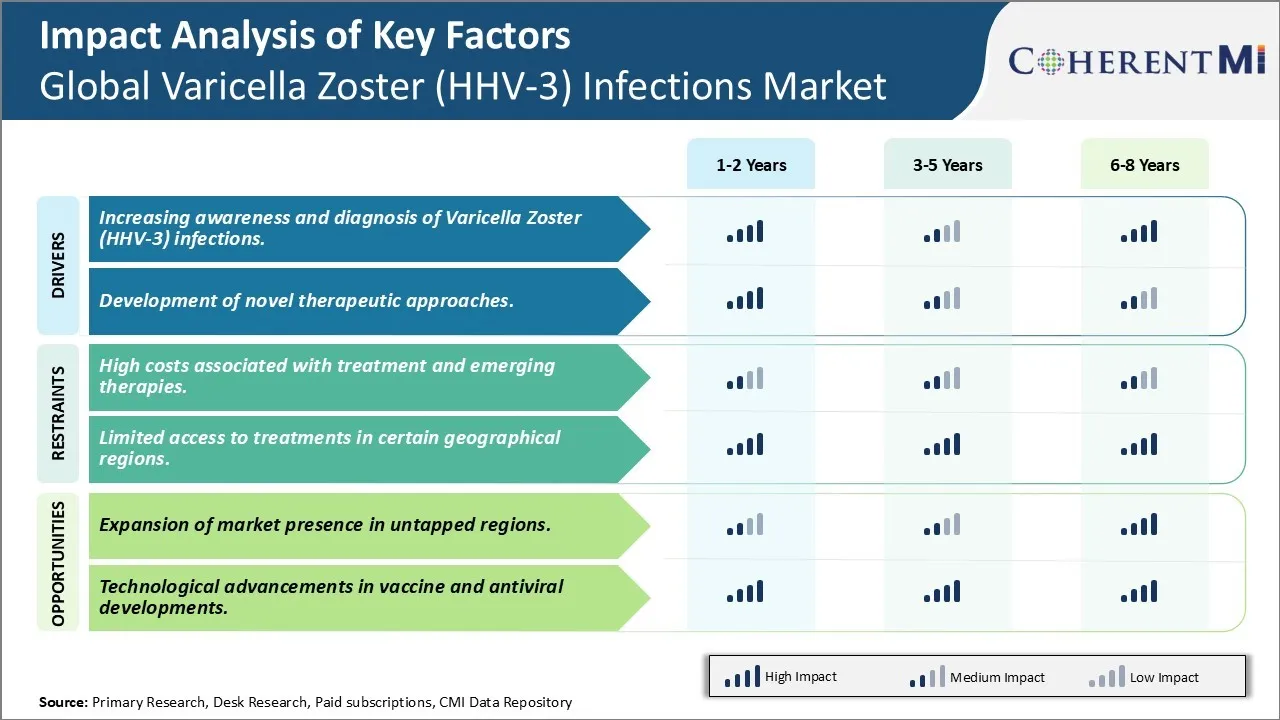Varicella Zoster HHV-3 Infections Market Trends
Market Driver - Increasing awareness and diagnosis of Varicella Zoster (HHV-3) infections.
As more light has been shed on the Varicella Zoster virus and the diseases it can cause, patients and physicians alike are becoming increasingly knowledgeable. Whereas shingles was once seen as an inevitable albeit unpleasant aspect of aging, we now understand it as a neurological infection that can often be prevented or treated. Efforts over the past decade have focused on educating the public that VZV remains latent in human bodies long after childhood chickenpox, and reactivation is possible whenever immunity wanes.
Awareness campaigns have emphasized that shingles risks rise sharply after age 50 and even earlier for those with compromised immune systems. Simple facts about the typical rash pattern and associated pains have equipped people to recognize symptoms and seek prompt healthcare. Diagnosis is now simpler through examination and sometimes swab tests, avoiding more invasive procedures of the past. Primary care doctors can accurately identify shingles in many cases based on appearance and patient history. This streamlines treatment decisions and alleviates suffering.
A related benefit comes from growing recognition that postherpetic neuralgia (PHN) can sometimes plague shingles patients long-term. Publicity around relieved yet debilitating nerve pain has spurred those afflicted to try available antiviral medicines and vaccines. It has also sparked interest in novel long-acting therapies currently in development. As baby boomers age into higher risk demographics, it is anticipated their proactive approaches will sustain demand. Continued dialogue sustaining foresight of VZV infections seems poised to further diagnosis and management.
Market Driver - Development of Novel Therapeutic Approaches boosts the market growth.
Patient and physician education supporting early action on zoster symptoms runs parallel to drug development pursuing new frontiers. Where antiviral pills and vaccines once comprised the primary arsenal, research never rests in its quest for improved outcomes. Some promising candidates harness cell-mediated immunity showing ability to boost waning protection conferred by earlier vaccines. Others take unique angles like genetically engineered antibody treatments or gene silencing approaches.
Still other pipelines evaluate therapeutic vaccine revamps delivering antigen in novel ways to stimulate protective T cells. Long-term delivery systems like monoclonal antibodies also offer hope for preventing PHN onset when administered shortly after rash appearance. Nanoparticle formulations represent another pathway under study, with potential for sustained drug levels at infection sites. Cell-based therapies too are in preliminary stages, exploring everything from modified immune cells to killing virus-infected neurons.
Such wealth of investigational options reflects decades of accumulated VZV knowledge alongside technological advances. While recent immunological insights into virus behavior invite creative remedies, challenges persist in translating ideas into approved, accessible interventions. Significant time and funding are required to navigate rigorous safety and efficacy testing. Nevertheless, even partial successes of works in progress may find roles as added or substitute lines of defense against these often troubling diseases. Continued therapeutic progress seems destined to lift quality of life for affected individuals globally.

Market Challenge - High costs associated with treatment and emerging therapies.
One of the major challenges currently faced by the global varicella zoster (HHV-3) infections market is the high costs associated with treatment and emerging alternative therapies. While the current standard of care includes antiviral medications such as acyclovir, famciclovir and valacyclovir, these drugs may be too expensive for some patients especially in developing regions. The introduction of newer innovative drugs and vaccines that are highly effective but also very expensive can further strain healthcare budgets and limit access to treatment. For instance, the recombinant zoster vaccine Shingrix which has a nearly 95% efficacy in preventing shingles for older adult costs around USD 280 per dose requiring two doses. Such prohibitive costs can impact widespread adoption and uptake of newer therapies. Additionally, as the population demographics shift towards more elderly individuals who are at higher risk of developing shingles, it is expected that total treatment costs of varicella zoster infections will continue increasing. This cost burden on patients as well as governments and healthcare systems remain a major challenge that needs to be addressed to ensure more equal access to effective therapies.
Market Opportunities- Expansion of market presence in untapped regions.
One of the key opportunities for growth in the global varicella zoster infections market lies in the potential to expand presence and sales in currently underpenetrated or untapped geographic regions. While developed markets in North America and Western Europe currently account for a major share of the overall market, there still exists significant room for growth in other developing parts of the world with large patient pools. Regions such as Latin America, Asia Pacific and parts of Africa and the Middle East have been historically lower adopters of newer vaccines and antiviral drugs due to various access barriers. However, with improvements in economic conditions and healthcare infrastructure as well as local manufacturing opportunities, these emerging markets are expected to increase demands in the coming years. Additional investments into awareness and education campaigns coupled with collaborations with regional healthcare providers can help boost both diagnosis and treatment rates globally. With a co-ordinated targeted market expansion approach, companies operating in this space stand to gain considerably by tapping into the lucrative growth prospects across neglected regions worldwide.